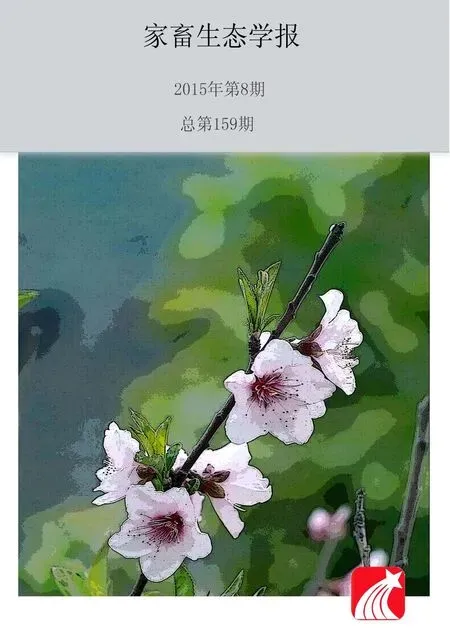金黄色葡萄球菌诱导的亚临床乳房炎小鼠血清IL-17研究1*
敬晓棋,刘健鹏,冯 平,黄光东,张 曦,闫海龙,屈 雷*
(1.榆林学院 生命科学学院 陕西省绒山羊工程技术研究中心,陕西 榆林 719000;2.榆林市动物疫病预防控制中心,陕西 榆林,719000;3.陕西溯源农业发展有限公司,陕西 西安 710000)
金黄色葡萄球菌诱导的亚临床乳房炎小鼠血清IL-17研究1*
敬晓棋1,刘健鹏2,冯 平1,黄光东3,张 曦2,闫海龙1,屈 雷1*
(1.榆林学院 生命科学学院 陕西省绒山羊工程技术研究中心,陕西 榆林 719000;2.榆林市动物疫病预防控制中心,陕西 榆林,719000;3.陕西溯源农业发展有限公司,陕西 西安 710000)
细胞因子与乳腺免疫紧密相关,IL-17是否是介导乳腺免疫的重要细胞因子对深入研究乳腺免疫机制和乳房炎防控具有重要意义。研究以分娩后7~12 d的C57BL/6小鼠为模型动物,将从隐性乳房炎的奶牛乳汁分离的金黄色葡萄球菌(S.aureus)50 μL(1×107CFU)或等量的无菌生理盐水通过乳导管缓慢注入小鼠第四、五对乳腺,分别于感染后2 h、4 h、8 h、12 h、18 h、24 h、36 h、48 h、60 h和72 h摘眼球采血并分离血清,通过ELISA法测定血清中IL-17A、IL-6、TGF-β的含量。结果显示IL-17在S.aureus感染后8~24 h含量升高,其中18 h时显著高于对照小鼠,48 h和时60 h IL-17低于对照小鼠,而IL-6和TGF-β含量无明显变化。研究结果表明,这小鼠存在已分化的记忆性IL-17分泌细胞,S.aureus的感染诱导其快速的分泌了IL-17,也证实IL-17也是乳房炎病理过程中的细胞因子之一。
小鼠乳房炎;血清;IL-17;IL-6;TGF-β
乳房炎是奶牛、奶山羊最常见和危害最大的疾病,严重影响奶牛、奶山羊产业的效益及乳制品的质量和安全。金黄色葡萄球菌(Staphylococcusaureus,S.aureus)是自然界广泛存在的一种能够引起人和动物多种疾病的条件性病原微生物,是奶牛、奶山羊等乳用动物临床和亚临床型乳房炎最主要病原菌之一[1-3]。改善和提高动物机体自身的防御机制预防和控制乳腺炎,是更为有效和安全的的措施[4]。
细胞因子是细胞与细胞交流的关键信使分子,并与维持机体免疫自稳及病理过程的调节有关[5]。乳腺炎病理过程中免疫细胞的活性主要受到促炎因子的调控,其作用包括增强巨噬细胞和中性粒细胞的杀微生物活性、促进中性粒细胞向感染部位的迁移、刺激树突状细胞成熟、调控获得性免疫反应[6]。目前,在健康乳腺和受感染的乳腺已发现IL(interleukin)-1β,IL-2,IL-6,IL-8,IL-12,IL-17,集落刺激因子(colony-stimulating factors,CSF),IFN-γ,及TNF(tumor necrosis factor)-α等多种细胞因子[7-9]。
在乳房炎研究中小鼠是组织免疫研究的最佳模型,避免了奶牛、奶山羊等家畜模型和试剂方面的不足。本研究通过乳汁分离的S.aureus诱导了C57BL/6小鼠的隐性乳腺炎,对乳腺炎症过程中小鼠血清中IL-6、IL-17、TGF(transforming growth factor)-β等细胞因子进行了系统性研究,探讨了隐性乳腺炎循环系统的免疫应答反应,对将来进一步研究乳腺免疫机制提供了有意义的参考。
1 材料与方法
1.1 试验材料
6周龄的C57BL/6小鼠购自第四军医大学实验动物中心,于西北农林科技大学动医学院动物中心饲养。小鼠饲养环境恒温(22 ℃)、恒湿,每天光照12 h,自由饮水和采食。小鼠适应新环境1周后,雌雄合笼交配。分娩后1周时,仔鼠不少于5只的母鼠用于S.aureus乳房炎模型建立。
1.2 菌 株
本研究所用金黄色葡萄球菌(Staphylococcusaureus,S.aureus)是从陕西关中地区患慢性乳房炎的关中奶山羊乳汁分离,经中国兽医药品监督所鉴定为金黄色葡萄球菌,并由西北农林科技大学动物免疫学实验室保存。
1.3S.aureus乳腺内注射
21只泌乳7~12 d C57BL/6的小鼠用于本次试验,其中18只为试验组,另3只为生理盐水对照。参考Brouillette and Malouin[10]的试验方法进行小鼠乳腺内S.aureus注射,具体如下。乳腺内注射前2 h将小鼠与仔鼠分离,小鼠按150~200 mg/kg的剂量腹腔注射注射氯胺酮,待小鼠麻醉后进行乳腺内注射。将小鼠用纸胶带仰面固定于泡沫板上,对其腹部第4对和第5对乳腺用70%酒精消毒,用32G针头通过乳导管将1×107CFU 的S.aureus缓慢注入乳腺,每个乳头50 μL。对照组注射等量的无菌生理盐水。小鼠放回笼子,自然苏醒。对照小鼠于乳腺内注射后24 h处死,试验组小鼠分别于乳腺内注射后8 h、12 h、18 h、24 h、48 h、60 h时处死,每个时间点3只。
1.4 小鼠血清细胞因子测定
摘眼球采血, 自然凝血30 min,3000 r/min离心30 min,吸取血清,―20 ℃冻存备用。
按照TGF-β ELISA试剂盒(R&D分装)、Mouse IL-6 ELISA MAXTMStandard(Biolegend Ltd.)和Mouse IL-17A ELISA MAXTMStandard(Biolegend Ltd.)试剂盒说明书进行小鼠血清IL-17A、IL-6、TGF-β含量的测定。
1.5 统计分析
结果用GraphPad Prism 5.01进行分析,P<0.05视为具有显著性差异,P<0.01视为差异极显著。
2 结果与分析
2.1 小鼠血清IL-17、TGF-β及IL-6水平
本试验通过ELISA对小鼠血清中IL-17、TGF-β及IL-6蛋白进行了测定,结果显示IL-17在S.aureus感染后8~24 h含量升高,其中18 h时显著高于对照小鼠(P<0.05),8 h和时60 h IL-17低于对照小鼠(图1)。与对照小鼠相比,S.aureus感染后试验小鼠血清中IL-6(图2)和TGF-β(图3)含量无明显变化。

图1 S.aureus 感染后小鼠血清IL-17A含量水平动态变化

图2 S.aureus 感染后小鼠血清IL-6含量水平动态变化

图3 S.aureus 感染后小鼠血清TGF-β(B)含量水平动态变化
3 讨 论
改善和提高动物机体自身的防御机制预防和控制乳腺炎,是更为有效和安全的的措施[4],其中促炎性细胞因子在介导抗感染免疫中发挥着关键作用[11]。IL-17作用于造血细胞、成纤维细胞、平滑肌细胞、上皮细胞,并诱导分泌IL-6、G-CSF、GM-CSF、IL-1β、TGF-β、TNF-α等多种炎性细胞因子分泌[12-13],诱导气管、肺、肠道、皮肤等黏膜部位中性粒细胞浸润,清除细菌、病毒、真菌等感染的病原微生物[14]。然而,鉴于奶牛、奶山羊等大型乳用动物的局限,深入的研究乳房炎发病过程中细胞因子等免疫效果的研究还需要通过实验动物模型进行。因此,本研究通过从奶山羊亚临床型乳房炎乳中分离的金黄色葡萄球菌诱导了小鼠乳房炎模型,对炎症过程中外周血IL-17、IL-6、TGF-β的含量变化进行了研究。
国内外在奶牛、奶山羊的研究结果显示IL-17及其分泌细胞在动物乳腺炎中可能具有关键作用[15-17]。本研究结果显示IL-17在S.aureus感染后8~24 h含量升高,其中18 h时显著高于对照小鼠(P<0.05),48 h和时60 h IL-17低于对照小鼠(图1)。结果表明在S.aureus感染的早期阶段,能够诱导机体外周血IL-7含量的升高,然而48 h后其含量降低,这可能与乳腺炎症反应减弱有关。尽管乳腺上皮细胞能够通过模式识别受体(pattern recognition receptors, PPRs)家族D的Toll样受体(toll-like-receptors, TLRs) 快速的感知S.aureus感染的信号,然而S.aureus并不能活化转录因子NF- κB,从而不能有效促进促炎性细胞因子合成、免疫应答强调减弱及最终导致隐性乳房炎[18],这也可能是本研究中S.aureus感染后8~24 h时IL-17含量升高,而之后含量降低的原因。
IL-6与TGF-β协同是IL-17分泌细胞分化的关键细胞因子条件[19-20]。然而本研究中,与对照小鼠相比S.aureus感染后试验小鼠血清中IL-6(图2)和TGF-β(图3)的含量无明显变化,这可能是由于机体本身就存在已分化的记忆性IL-17分泌细胞,S.aureus的感染诱导其快速的分泌了IL-17[21],这也与乳腺IL-17免疫组织化学研究结果一致,乳腺内天然存在一定数量的IL-17分泌细胞。
4 结 论
本研究在小鼠模型上证实了IL-17也是乳房炎病理过程中的细胞因子之一,然而IL-17及其分泌细胞是否是调控乳腺炎症的关键还有待进一步的深入研究。
[1] Watts J L. Etiological agents of bovine mastitis[J]. Veterinary Microbiology, 1988,16(1): 41-66.
[2] 牟 珊, 韩炎森, 雷丽辉,等. 关中奶山羊乳房炎病理模型的建立. 动物医学进展, 2011,32(6): 51-55.
[3] 姚运亮, 田婷婷, 许君艳,等. 关中奶山羊隐性乳房炎病原菌的分离鉴定. 动物医学进展, 2013,34(4): 116-119.
[4] Kotwal G J. Microorganisms and their interaction with the immune system[J].Journal of Leukocyte Biology, 1997,62(4): 415-429.
[5] Chang S H,Dong C.Signaling of interleukin-17 family cytokines in immunity and inflammation[J]. Cellular Signalling, 2011, 23(7):1 069-1 075.
[6] Alluwaimi A,Cullor J. Cytokines gene expression patterns of bovine milk during middle and late stages of lactation[J]. Journal of Veterinary Medicine, Series B, 2002,49(2): 105-110.
[7] Sordillo L M,Streicher K L.Mammary gland immunity and mastitis susceptibility[J]. J Mammary Gland Biol Neoplasia, 2002,7(2): 135-146.
[8] Alluwaimi A M.The cytokines of bovine mammary gland: prospects for diagnosis and therapy[J]. Research in Veterinary Science, 2004,77(3): 211-222.
[9] Zhu Y, Berg M, Fossum C,et al. Proinflammatory cytokine mRNA expression in mammary tissue of sows following intramammary inoculation with Escherichia coli[J]. Vet Immunol Immunopathol, 2007,116(1-2): 98-103.
[10] Brouillette E,Malouin F. The pathogenesis and control of Staphylococcus aureus-induced mastitis: study models in the mouse[J]. Microbes and Infection, 2005,7(3): 560-568.
[11] Zhang J X, Zhang S F, Wang T D,et al. Mammary gland expression of antibacterial peptide genes to inhibit bacterial pathogens causing mastitis[J]. J Dairy Sci, 2007,90(11):5 218-5 225.
[12] Guglani L,Khader S A. Th17 cytokines in mucosal immunity and inflammation[J]. Curr Opin HIV AIDS, 2010,5(2): 120-127.
[13] Rubino S J, Geddes K,Girardin S E. Innate IL-17 and IL-22 responses to enteric bacterial pathogens[J]. Trends Immunol, 2012,33(3):112-118.
[14] Kolls J. Il-17/Il-22 in Infection[J]. Inflammation Research, 2010,59:109-110.
[15] Tao W,Mallard B. Differentially expressed genes associated with Staphylococcus aureus mastitis of Canadian Holstein cows[J]. Vet Immunol Immunopathol, 2007,120(3-4): 201-211.
[16] Pisoni G, Moroni P, Genini S,et al.Differentially expressed genes associated with Staphylococcus aureus mastitis in dairy goats[J]. Vet Immunol Immunopathol, 2010,135(3-4): 208-217.
[17] Jing X Q, Zhao Y Q, Shang C C,et al. Dynamics of cytokines associated with IL-17 producing cells in serum and milk in mastitis of experimental challenging with Staphylococcus aureus and Escherichia coli in dairy goats[J]. Journal of Animal and Veterinary Advances, 2012,11(4): 475-479.
[18] Yang W, Zerbe H, Petzl W,et al. Bovine TLR2 and TLR4 properly transduce signals from Staphylococcus aureus and E. coli, butS.aureusfails to both activate NF-κB in mammary epithelial cells and to quickly induce TNF-α and interleukin-8 (CXCL8) expression in the udder[J]. Mol Immunol, 2008,45(5): 1 385-1 397.
[19] Bettelli E, Carrier Y, Gao W,et al. Reciprocal developmental pathways for the generation of pathogenic effector TH17 and regulatory Tcells[J]. Nature, 2006,441(7090): 235-238.
[20] Mangan P R, Harrington L E, Wahl S M,et al. Developmental requirements for Th17 effector T cells[J]. J Immunol, 2006,176:14-14.
[21] Witowski J, Pawlaczyk K, Breborowicz A,et al. IL-17 stimulates intraperitoneal neutrophil infiltration through the release of GRO α chemokine from mesothelial cells[J]. J Immunol, 2000,165(10):5 814-5 821.
IL-17 in Sera of Mice with Subclinical Mastitis Induced withStaphylococcusaureus
JING Xiao-qi1, LIU Jian-peng2, FENG Ping1, HUANG Guang-dong3, ZHANG Xi2, YAN Hai-long1, QU Lei1*
(1.ShaanxiEngineeringTechnologyResearchCenterofCashmereGoat,LifeScienceCollege,YulinUniversity,Yulin,Shaanxi, 719000; 2.YulinCenterOfAnimalDiseasePreventionAndControl,Yulin,Shaanxi, 719000; 3.ShaanxiShuoyuanAgriculturalDevelopmentLtd,Xi'an,Shaanxi, 710000)
Cytokines is related closely with mammary gland immunity. Whether IL-17 is an important cytokines affecting mammary gland immunity means much to the study of mammary immunity mechanism and mastitis prevention . Lactating C57BL/6 mice as the research animal were challenged 7 to 12 days after parturition. A 32 G needle with a blunt end was then inserted into the fourth and fifth teat canal and a volume of 50 μL was slowly injected. Challenged mice received 1×107CFU ofS.aureusin every challenged mammary gland while control mice were inoculated with germ-free saline in all challenged glands. The concentrations of IL-17, IL-6, TGF-β in sera of mice were examined at 2 h,4 h,8 h,12 h,18 h,24 h,36 h,48 h,60 h and 72 h after infection. The results displayed that the level of IL-17 in sera increased 24 h after infection withS.aureusand its value was sifnificantly higher than that in the control mice 18 h after infection. However, the level of TGF-β and IL-6 in sera were not significantly different compared with that in control group. The results suggested that IL-17 may be an important cytokine in mediating the inflammation of mammary gland when infected withS.aureus.
mice mastitis, sera, IL-17, IL-6, TGF-β
2015-01-29
2015-04-02
2013年度陕西省教育厅项目(2013JK0706);榆林学院校内重点项目(13YK42);榆林学院博士科研启动基金(14GK38)
敬晓棋(1977-),男,陕西凤翔人,博士,副教授,主要从事动物疫病防控和动物生物技术研究。E-mail:jingxiaoqi@126.com
*[通讯作者] 屈 雷(1969-),男,陕西定边人,博士,教授,主要从事动物疫病防控和动物生物技术研究。E-mail:ylqulei@126.com
S811.6
A
1005-5228(2015)08-0066-04

